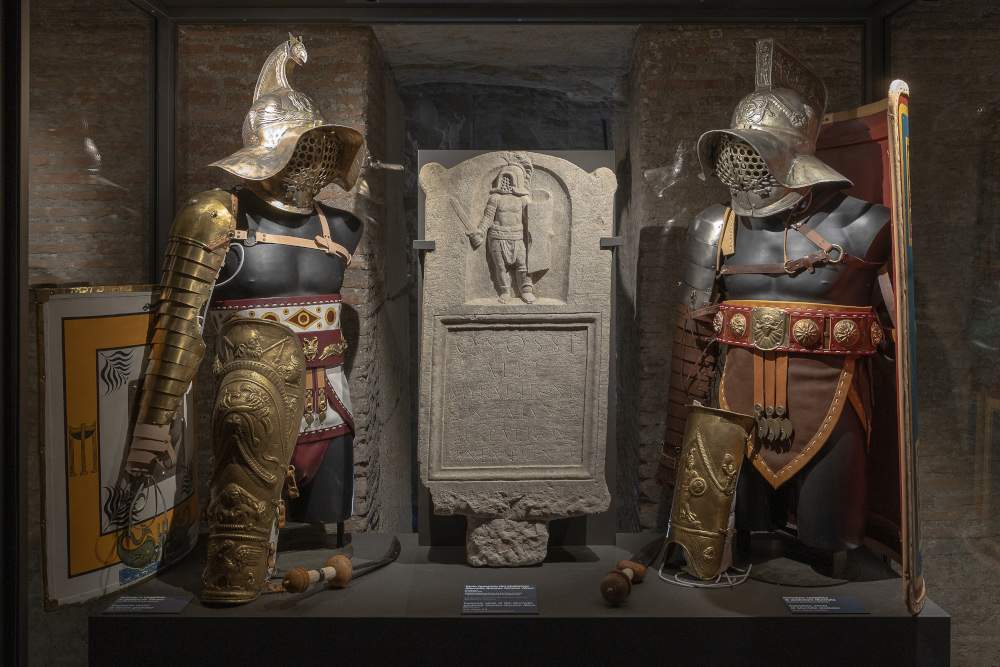Gladiators in the arena, the new exhibition at the Colosseum Archaeological Park
The Colosseum Archaeological Park presents Gladiators in the Arena. Between Colosseum and Ludus Magnus, an exhibition project conceived and implemented by the Colosseum Archaeological Park under the curatorship of Alfonsina Russo, Federica Rinaldi, Barbara Nazzaro and Silvano Mattesini. Visible from July 21, 2023 to Jan. 7, 2024 inside the Colosseum’s basement, the event consists of a permanent multimedia installation and a temporary exhibition.
The idea for this initiative stems from the recovery and enhancement of the eastern cryptoporticus of the Colosseum, which in Roman times connected the Arena with the gymnasium district built by Emperor Domitian, the most famous of which is the Ludus Magnus, the largest but also the only one of which part of the ancient structures is preserved. Here gladiators trained and prepared for performances.
In the 19th century, the construction of a sewer serving the densely populated Esquiline district disrupted this ancient connection, which today is restored: thanks to a sophisticated multimedia presentation with holographic projection, perfectly oriented on the Colosseum-Ludus Magnus axis, the wall interrupting the connection will be virtually “demolished,” thus restoring to the public a unified vision of the contemporary archaeological area, while the gladiators will return to ploughing the original opus spicatum floor of the cryptoporticus, advancing toward the Arena dressed in their heavy armor.
In order to make this experience of knowledge and appreciation even more complete, the reopening of the Cryptoporticus of the Gladiators will also be narrated by a temporary exhibition that intends to illustrate a selection of the main types of pairs of gladiators who performed in combat on the floor of the Arena and who in all probability right from the Ludus Magnus and the neighboring barracks arrived at the Colosseum.
The display, which winds its way through some of the underground rooms of the hypogea, combines original finds from the Roman era, which reproduce images of gladiators caught in typical fighting positions, with reconstructions, true to life, of their armor, made according to the ancient technique of embossing and casting by Master Silvano Mattesini. Thus, it is possible to admire the complete armors of Murmillo and Thraex, alongside the original helmets from Pompeii from the National Archaeological Museum in Naples, the precious amber miniature helmets from the National Archaeological Museum in Aquileia, and the funerary stele of Murmillo Quintus Sossius Albus, likewise from Aquileia. Also on public display are graffiti from the steps of the Colosseum cavea in which the public of the time had depicted their favorites in combat, alongside the complete armor of a Retiarius and a Secutor. That of the Hoplomachus with his typical round shield, an opponent of the Murmillo, is displayed alongside two statuettes from Aquileia, one also in metal alloy. Finally, a video illustrates the stages of armor reproductions, forged using ancient techniques as part of an experimental archaeology project.
“The enhancement of the Cryptoporticus and the underground, with the telling of what actually took place in these places, restores the context to its original function and is fully part of the cultural strategy that distinguishes the actions of the Colosseum Archaeological Park,” says Alfonsina Russo, director of the Colosseum Archaeological Park. “Expanding the cultural offer with innovative technologies, which make it possible to make the function and historical events of the monuments immediately perceptible, is one of the primary objectives that the PArCo has always pursued, also with the public-private partnership that over the years has contributed to the realization of important projects aimed above all at improving fruition and accessibility, both physical and cultural.”
The PArCo has accepted the proposal of a partnership with the Hornblower Group, a leading U.S. transportation and tourism company founded in Boston in 1926, orienting its mission toward a policy of public-private partnerships.
“Hornblower Corp. has always been committed to offering high-quality services and experiences to its customers, as well as involved in sustainability projects in the environmental and social spheres,” says the company. “The idea of being able to support the restoration of a portion of the Colosseum’s Underground and to revive the scenes of the Gladiators’ passage from the tunnel that connected them to the Ludus Magnus, was immediately welcomed as a great and exciting opportunity to give back to the world a ’small’ piece of history never seen before. The understanding with the Archaeological Park was immediate, as was the sharing of the cultural and educational value of this project.”
The centerpiece of the exhibition is the Cryptoporticus, which, as anticipated, connected the Colosseum with the neighborhood of the training schools, comprising in addition to the Ludus Magnus also the Ludus Gallicus, the Matutinus and the Dacicus, the headquarters for the sailors of the Misenum fleet assigned to maneuver the velum, the Castra Misenatium, the storerooms for Weapons, the Armamentaria, the hospital or Saniarium, the Spoliarium, where the bodies of dead combatants were undressed, and finally the Summum Choragium, a factory and storehouse for the scenery. The Cryptoporticus runs up to the modern interruption and still retains the original brick pavement arranged in a herringbone pattern (opus spicatum), part of the travertine vault and patches of plaster covering on the walls. The Cryptoporticus will remain open to visitors even after the end of the exhibition, strikingly enriching the tour of the hypogea.
Image: Complete armor of Murmillo, funerary stele and complete armor of Thraex © Colosseum Archaeological Park
 |
| Gladiators in the arena, the new exhibition at the Colosseum Archaeological Park |
Warning: the translation into English of the original Italian article was created using automatic tools. We undertake to review all articles, but we do not guarantee the total absence of inaccuracies in the translation due to the program. You can find the original by clicking on the ITA button. If you find any mistake,please contact us.





























